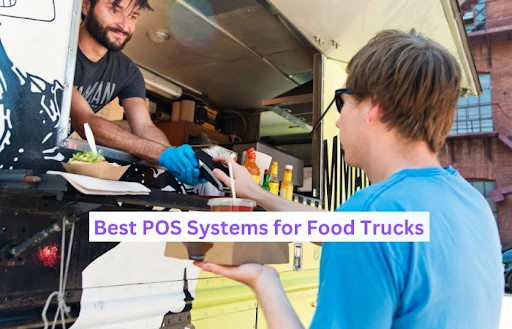The most optimal point-of-sale (POS) systems for food trucks are cost-effective, adaptable, and meticulously tailored to meet the needs of mobile restaurants. When selecting the appropriate POS system for your establishment, it is imperative to take into account the monthly expenses, payment processing fees, add-on features like a loyalty program, waitlist management, and the array of mobile hardware options, to identify the most suitable solution for your business.
In the fast-paced world of food trucks, a reliable and efficient Point of Sale (POS) system is essential for smooth operations. As food truck businesses continue to thrive, the significance of organized order management, accurate transactions, and improved customer service cannot be overstated. To meet these needs, a new generation of specialized POS systems tailored for food trucks has emerged, revolutionizing the operations of these businesses.
This blog explores the realm of food truck POS systems and presents the top five options available in 2024. These advanced solutions empower food truck owners and operators to effectively manage their operations, enhance performance, and provide exceptional dining experiences.
From customizable menu management and inventory tracking to mobile payment processing and real-time analytics, these POS systems for food trucks offer a comprehensive set of features designed to meet the unique demands of food truck businesses. With user-friendly interfaces and intuitive design, they simplify day-to-day tasks, enabling owners to focus on their primary goal: serving delicious food to their customers.
How can food trucks benefit from POS systems?
Food truck businesses, whether single or multiple, can derive several advantages from POS systems:
- Streamlined Order Management: POS systems enable food truck operators to efficiently handle customer orders, reducing errors and improving order accuracy. Orders can be swiftly input into the system, customized to meet customer preferences, and seamlessly transmitted to the kitchen or food preparation area. Additionally, some options may integrate with a kitchen display system.
- Efficient Payment Processing: POS systems allow food trucks to accept various payment methods, including cash, credit cards, mobile payments, and contactless transactions. Integrated payment processing helps operators expedite transactions, reduce wait times, and provide a seamless payment experience for customers.
- Inventory Management and Cost Control: POS systems with inventory tracking capabilities assist food truck owners in monitoring ingredient usage, tracking inventory levels in real-time, and streamlining inventory ordering. This ensures that food trucks maintain optimal stock levels, minimize wastage, and effectively control costs. With a clear view of inventory, operators can make informed purchasing decisions and prevent stockouts.
- Sales and Performance Insights: POS systems generate detailed reports and analytics that offer valuable insights into sales trends, customer engagement, popular menu items, and peak hours. Through the analysis of this data, food truck operators can make well-informed decisions to enhance their menu, pricing strategies, and operational efficiency. This data-driven approach facilitates the increase of profitability and the improvement of customer satisfaction.
- Mobility and Flexibility: Some food truck POS systems allow business owners to manage multiple food trucks and are mobile-friendly, enabling operators to take orders and process payments directly at the customer’s location. This flexibility eliminates the need for customers to queue up at a stationary point of sale, enhancing customer service and improving the overall dining experience.
How to select the best food truck POS system
When choosing a food truck POS system, it’s important to consider several factors. Given the dynamic nature of food truck operations, it’s essential to opt for a POS system designed with mobile functionality and a user-friendly interface. The system should be designed to be user-friendly, intuitive, and accessible on a range of mobile devices. Additionally, it’s important to seek a POS system that provides robust online ordering capabilities tailored to food trucks.
Reliable systems for food trucks should support a wide range of payment methods, including cash, credit cards, mobile payments, and contactless transactions. It should seamlessly integrate with payment processors and ensure secure and dependable transaction processing. Furthermore, ensure that your POS system offers comprehensive reporting and analytics capabilities. It should provide insights into sales trends, popular menu items, customer preferences, and other key performance indicators. Access to this data will facilitate informed business decisions and enable you to optimize your food truck operations.
Elevate your restaurant’s performance with proven strategies. Dive into our blog now and start implementing the tactics that lead to success!
Selecting the appropriate food truck POS for your business is essential for ensuring efficient operations and a positive customer experience. Follow the steps outlined below to identify the most suitable system for your food truck.
Step 1: Assess Your Needs
Commence by evaluating your specific requirements as a food truck operator and those of your staff. Consider the list of features provided to ascertain which functions are most critical for your business and which ones could be omitted. Take into account your distinctive operational needs, customer demands, market trends, and plans for future expansion.
Step 2: Set a Budget
Establish a budget based on your financial capabilities. Take into consideration both one-time expenses (hardware and installation) and ongoing costs (monthly software fees). Ensure that the POS system you choose is in line with your budget and offers a pricing structure that aligns with your business model.
Step 3: Schedule Demos
With your needs and budget requirements in mind, schedule demonstrations with several POS providers to gain firsthand experience with their systems. Pay close attention to the ease of use, functionality, and speed of each system, while also evaluating the quality of customer support provided by the vendor. Be sure to inquire about budget alignment, including features, integrations, scalability, fees, and installation timelines.
Step 4: Compare Estimates
Following the demonstrations, the POS providers will typically furnish you with an itemized estimate outlining the anticipated costs for software, hardware, and payment processing (if applicable). Thoroughly review the estimates, comparing not only the monthly costs but also the contract terms, installation fees, and any other pertinent conditions. Ensure that there are no hidden fees or unexpected obligations.
Step 5: Finalize Your POS Decision
Upon comparing the estimates and making your final decision, reach out to your selected POS provider to initiate the implementation process. It is courteous to inform the other providers you considered of your decision, thereby saving time and preventing unnecessary follow-up calls and emails.
What is the top food truck POS system?
Identifying the “ideal” POS system for food trucks depends on a range of factors and specific business needs. Various POS systems provide different features, pricing plans, and customization levels. While a good POS system might offer a free plan option, free software solutions often entail high payment processing costs and hardware expenses. When seeking a dependable full POS system, the best solutions typically involve a monthly software subscription fee – but the investment is worthwhile. Below are the top 5 systems to consider, along with their features and benefits for your food truck business:
Milagro
Pros
- Tailored for the restaurant industry
- Useful features such as a smart menu, customer data platform, AI marketing, and more
- Customizable add-ons
- Easy-to-use interface
- Best customer support
Cons
- Additional features and programs are add-ons for all plans
About
Milagro is a point-of-sale (POS) system that enables food truck operators to efficiently manage their operations. Although Milagro POS is designed for food trucks and other restaurant types, Milagro offers comprehensive features that can be adjusted to meet the specific needs of mobile food businesses. With its flexibility and core capabilities, Milagro provides a robust solution for food truck owners, facilitating seamless order management, streamlined payment processing, efficient inventory control, comprehensive reporting and analytics, and improved customer management.
While primarily intended for physical businesses, Milagro allows you to create customer profiles, track purchase history, and deliver personalized experiences. It also integrates with various third-party systems and services such as online ordering platforms, accounting software, or delivery services, and can be used on mobile devices, offering flexibility and mobility for your food truck operations.
Square

Pros
- Baseline POS is available for use at no cost
- No long-term contracts required
- Can utilize existing hardware
- Supports handheld payment terminals
Cons
- Square is the sole payment processor
- Ingredient-level inventory management necessitates third-party integration
- Free POS only allows for one set of user permissions
About
Square is a versatile POS system that encompasses features such as credit card processing, inventory tracking, and invoice creation. Although not specifically tailored for food-related businesses, its $0 fee and comprehensive basic features can make it an appealing choice for new food truck owners or those seeking a cost-effective option.
Square’s app is compatible with both Android and Apple devices, enabling you and your employees to transform any phone into sales hardware. The company also provides various types of portable hardware, allowing customers to conveniently place orders while standing outside their trucks.
Additionally, Square integrates with third-party delivery platforms like DoorDash and Postmates, enabling you to offer delivery services.
Toast

Pros
- The baseline subscription does not entail any software fees
- Pay-As-You-Go options provide up to two Toast terminals without any initial costs
- Incorporates invoicing tools
- The industry-grade hardware is designed to withstand high-volume usage
Cons
- Bound to Toast Payments
- May offer more tools than what small trucks require
- Mandates a two-year contract
About
Toast was specifically created for restaurants, so it provides numerous features that align well with food trucks. The basic plan includes the capability to design and share digital menus, generate sales reports, and conduct straightforward payment processing.
Additionally, Toast offers optional features such as a customer loyalty program, email marketing, and online ordering. You have the flexibility to select and customize these features, allowing you to meet your business’s requirements while only paying for the functionalities you will utilize.
TouchBistro

Pros
- iOS-based interface is user-friendly, akin to a smartphone
- Operates on iPads for terminals, KDS screens, self-ordering kiosks, and handheld devices
- Can be self-installed
Cons
- Bound to TouchBistro Payments
- Higher baseline price compared to others on the list
- Hardware pricing and payment processing rates necessitate a custom quote
- Built-in ingredient-level inventory entails administrative time for updates
About
TouchBistro is a dedicated POS system tailored for food establishments such as restaurants and food trucks. It encompasses considerate features aimed at addressing common industry challenges and bolstering sales. For instance, it allows for seamless menu design and real-time updates, enabling staff to focus on food preparation during peak hours while effortlessly removing sold-out items.
At the end of the day, sales reports offer insights into the performance of dishes at each location and the popularity of items at specific times. These reports can be accessed remotely and shared with employees via email.
Clover

Pros
- Compatible with industry-standard hardware
- Offers flexibility with month-to-month subscriptions or one-time upfront payments
- Baseline POS includes complimentary loyalty and invoicing tools
Cons
- Reporting capabilities are limited
- Inventory management necessitates third-party integration
- The quality of customer support varies based on the system’s point of purchase
About
Clover’s customer-facing display and streamlined menu designs facilitate the creation of customer-friendly menus. It also supports menu modifiers, such as dressing on the side or extra cheese, enabling the tracking of custom orders, even during busy periods.
Despite Clover’s higher monthly fee compared to many other POS systems, it includes features that some other systems offer as add-ons. Standard inclusions are no-fee online ordering, tax reporting, promotions, and customer loyalty programs.
Bottom Line
Food truck operations have unique characteristics such as speed, limited space, and unpredictable locations. Therefore, an adaptable, user-friendly, and cost-effective POS system is essential for optimal performance. This is why we recommend Milagro as the top choice for food truck POS.
Milagro offers invoicing, text and email marketing, and a range of hardware options, allowing you to customize the POS to suit any food truck style. Additionally, Milagro can scale alongside your business growth and changing needs. The absence of a long-term contract makes Milagro for Restaurants a low-risk choice for new or seasonal food trucks.
Uncover strategies to maximize profits in your food truck venture.






